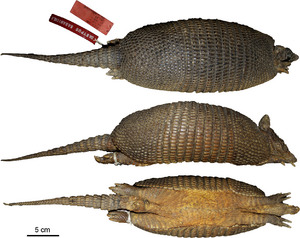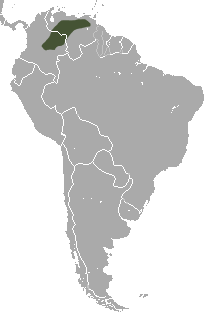Llanos long-nosed armadillo facts for kids
Quick facts for kids Llanos long-nosed armadillo |
|
|---|---|
 |
|
| Conservation status | |
| Scientific classification | |
| Genus: |
Dasypus
|
| Species: |
sabanicola
|
 |
|
| Llanos long-nosed armadillo range | |
The Llanos long-nosed armadillo (Dasypus sabanicola), also called the northern long-nosed armadillo, is a type of armadillo. It belongs to the Dasypodidae family. This armadillo lives only in Colombia and Venezuela. It makes its home in the Llanos, which are huge grasslands that sometimes flood.
This armadillo is related to the nine-banded armadillo. It has very little hair on its body. An adult can weigh up to 22 pounds (9.5 kg). It can also grow to about 2.1 feet (60 cm) long. It prefers to live in thick bushes near limestone rocks. Like most other armadillos, it mainly eats ants.
Contents
What Does the Llanos Armadillo Look Like?
Like other armadillos in its group, the Llanos long-nosed armadillo has a special outer shell. This shell is called a carapace. It is a hard, armor-like covering. It is made of bony plates under leathery skin.
The back part of its body has six to eleven movable bands. These bands help the armadillo bend and move easily. Its tail also has armor. But its face, neck, and belly do not have armor. These parts have a few pale hairs. The armadillo has short legs. Its front feet have four toes, and its back feet have five. All its toes have strong claws.
Adult armadillos can grow to about 22 inches (570 mm) long from head to body. Their tail can be up to 19 inches (483 mm) long. They can weigh up to 22 pounds (10 kg).
Where Do Llanos Armadillos Live?
This armadillo lives only in the tropical northern part of South America. You can find it in the lowlands of Venezuela and Colombia. It lives at heights from about 82 feet (25 m) to 1,640 feet (500 m) above sea level. Its home is the Llanos. This is a very large grassy plain that gets flooded from time to time.
Llanos Armadillo Life and Habits
The Llanos long-nosed armadillo has a home area. This area can be between 4.2 and 28.7 acres (1.7 and 11.6 hectares). It comes out to find food at dawn and dusk. It eats small creatures without backbones. These include ants, termites, and beetles.
In Venezuela, these armadillos usually have babies between October and March. A mother armadillo typically has four babies at a time. Like other armadillos in the Dasypus group, all the babies come from a single egg. This means they are identical quadruplets.
Why Are Llanos Armadillos in Danger?
The grassy plains where the Llanos long-nosed armadillo lives are changing. More and more land is being used for making special fuels. It is also used for large farms and tree plantations. This means there is less good habitat for the armadillo.
Scientists have not counted how many of these armadillos there are. But people who live in the area hunt them for food. They also say they see the armadillo less often now. Because of these reasons, a group called the International Union for Conservation of Nature has looked at the animal's situation. They have decided it is "near-threatened." This means it could become endangered in the future if things do not change.


